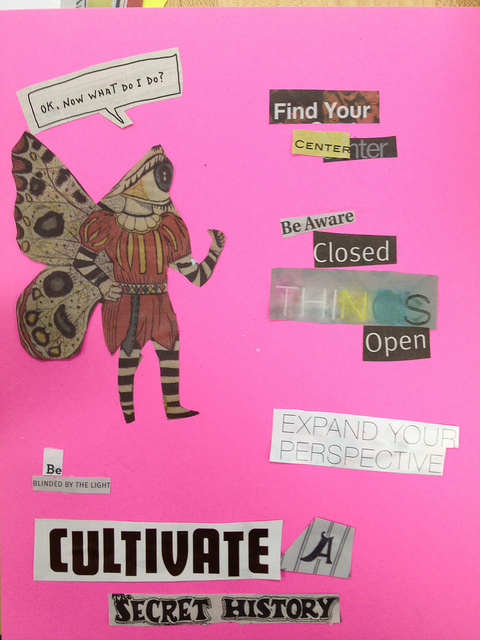
Be Aware Closed Things Open
[flickr id=”8003106767″ thumbnail=”medium_640″ overlay=”true” size=”original” group=”” align=”none”]
On the first Thursday of the semester, thousands of students, teachers, staff, and guests explored the campus for Columbia Crawl, the college’s annual art crawl. I was asked to participate by my department, and the task was to create an interactive poetry center that would be open to anyone attending the crawl. Thinking as a teacher, this meant to me that the activity had to be accessible and flexible for a variety of age groups and learning abilities. Thinking as an artist, I wanted to give the participants of the art crawl something visual to manipulate that would inform their writing. I started pouring through my teaching resource books, the majority of which are relatively unconventional titles. A spark of an idea came to me from the book How to Be an Explorer of the World, an excellent activity book that asks you to use the world around you as a portable museum from which to conduct investigations. Not all of it is appropriate for grade school level students, but oftentimes books like this offer accessible and transferable ways to tackle deep concepts. The activity that particularly caught my eye involved collecting paint chips from the hardware store and renaming the colors by matching them to colors that make up your world.
[flickr id=”8003110401″ thumbnail=”medium” overlay=”true” size=”original” group=”” align=”none”]
I decided that my poetry center would focus on connecting color to memory and using that to inspire the topic of the writing. I asked the participants to look through the paint chips and select one that sparked, “a memory of an object, a place, or a person.” After they had selected their color, I suggested they give the color a new name that reflected their memory. Once that task was complete, I asked them to write a poem that connected the color and the memory together.
[flickr id=”8003112454″ thumbnail=”medium” overlay=”true” size=”original” group=”” align=”none”]
Because I am a tactile learner at heart and wanted to include some constructivism in the task, I also gave the participants the option of using newspapers collected around campus to inform their poem. This task was more open-ended and allowed them to decide if they wanted to use an image, a word, a sentence, or a series of words cut out that they felt fit together. Many of the visitors to the center combined the two activities together to create some compelling pieces of art and writing.
[flickr id=”8003109353″ thumbnail=”medium” overlay=”true” size=”original” group=”” align=”none”]
I was surprised by the amount of visitors we had over the evening, including the Dean of the School of Liberal Arts and Sciences, Dr. Deborah Holdstein. I had never met her before, but found her to be very charismatic, thoughtful, and witty. Her poem reflected on memories from Kindergarten art class. Some members of the Art Education cohort, including Ashley Saunders, also came through to make poetry with me. We also saw representatives from the undergrad early childhood education program and from my own cohort. Overall, it was an excellent experience and one that helped me think through a project for a wide variety of people.
[flickr id=”8003104483″ thumbnail=”medium_640″ overlay=”true” size=”originial” group=”” align=”none”]
